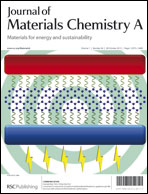Isosorbide-methacrylate as a bio-based low viscosity resin for high performance thermosetting applications
Abstract
In recent years, the bio-refining industry has developed a number of cyclic molecules with unique attributes derived from renewable carbohydrate feedstocks. Isosorbide is one such compound that has a distinctive fused bicyclic ring system that provides a scaffold for the development of novel bio-based resin systems. We synthesized isosorbide-methacrylate (IM) by the direct esterification of isosorbide using highly reactive species such as methacryloyl chloride or methacrylic anhydride and a base catalyst. IM is a low viscosity (157 cP) cross-linking resin that free radically reacts to form a thermoset polymer with extent of cure at 85%. The resulting polymer has a Tg greater than 240 °C and main degradation temperature of ∼400 °C. Mechanical test results showed that IM had a modulus of ∼4 GPa and strength of 85 MPa. These thermal and mechanical properties show that IM has a significantly higher temperature operating window than any known vinyl ester resin and has similar performance to expensive high temperature epoxy resins. As such, this material has good potential for use in composite applications where a moderate to high temperature free radical cured polymer matrix is needed.


 Please wait while we load your content...
Please wait while we load your content...